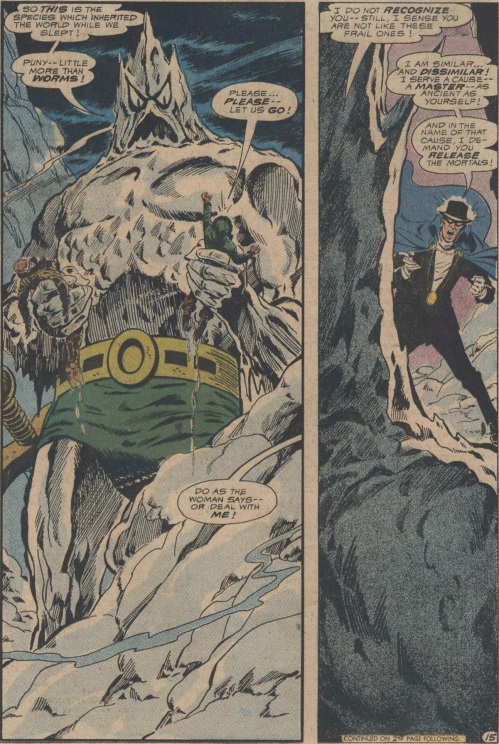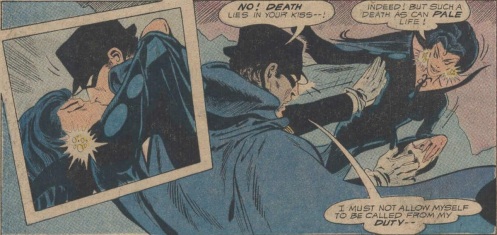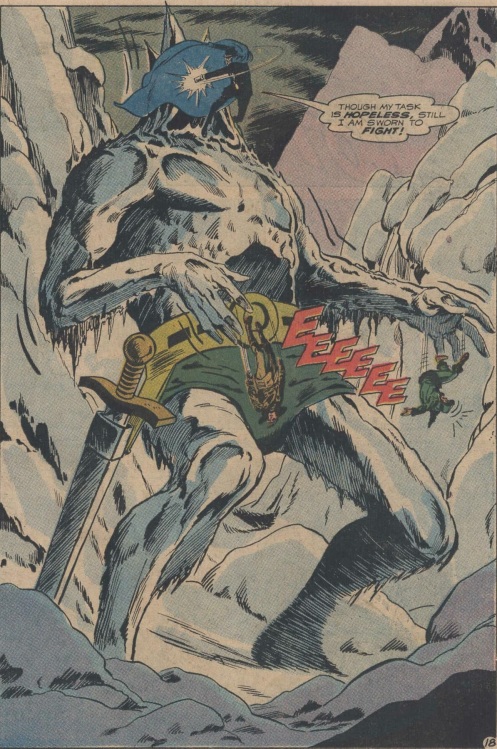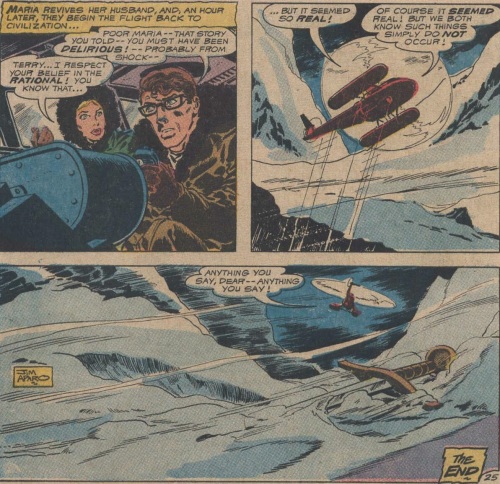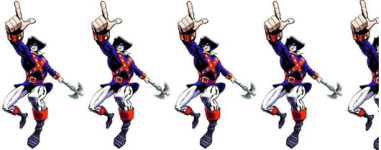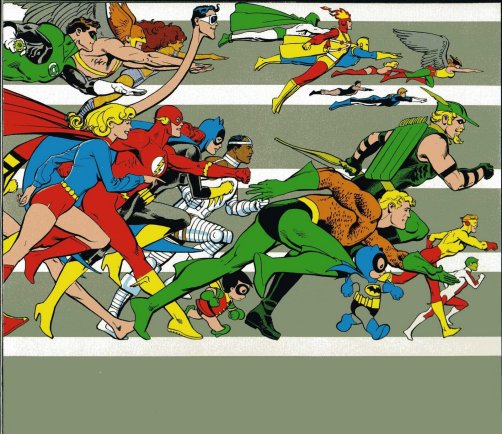
Welcome to another edition of Into the Bronze Age! With all of the madness that is loose in our world these days, I imagine we can all use more joy and adventure. I know I quite enjoy my visits to the Bronze Age. It helps to take the mind off of the utter insanity of our own times. We’ve got a book I dreaded and I book I eagerly awaited on the docket for this post. Let’s jump right in, shall we?
Roll Call (You can see everything published this month HERE)
- Action Comics #392
- Batman #225
- Brave and the Bold #91
- Detective Comics #403
- The Flash #200
- G.I. Combat #143
- Green Lantern/Green Arrow #79
- Justice League #83
- Showcase #93
- World’s Finest #196
Bolded entries are covered in this post, the others will be covered soon.
Green Lantern/Green Arrow #79
 “Ulysses Star is Still Alive!”
“Ulysses Star is Still Alive!”
Writer: Dennis O’Neil
Penciler: Neal Adams
Inker: Dan Adkins
Editor: Julius Schwartz
Well, we can’t avoid it any longer, I suppose. It’s time for another return to the parade of self-righteousness and poor decision-making that is the Green Lantern/Green Arrow book. Fortunately, this issue isn’t as bad as the some of the previous outings. It’s central concern is a very legitimate one, and it even manages to feel timely for us today, given the contents of our headlines in recent months. However, this wouldn’t be a Green Lantern/Green Arrow adventure without some infuriatingly obnoxious bloviating from Ollie and some irrational inflexibility from Hal, as well as a generally pervading, pointlessly aggressive stupidity and hotheadedness from both of these supposedly heroic men. Still, these qualities are a bit less on display here than they have been. Let’s take a look, shall we?
We join our hard traveling heroes camped on a quiet and peaceful night out in the wilderness, not far from where they had their last adventures with the pseud0-Manson Family. I probably haven’t said quite enough in praise of Adams’ art on this book, given my general frustration with O’Neil’s plots and characterization, but he really does do fantastic work. He packs his panels with personality and visual interest. In the simple scene around the camp fire, each character is doing something that tells you a bit about them. Hal is reading, Ollie is whittling, and the Guardian is floating in apparent meditation. That’s a nice touch. The quiet of this idyllic scene is shattered when these two veteran heroes detect some slight sign that something is amiss, and they leap into action to investigate. That’s a good another nice touch. It makes sense that these two have been at their dangerous work long enough that they’d have combat-honed senses. It makes them seem competent and professional. The adventure that follows doesn’t quite match that setup, though.

The Green Guardians discover an unlikely pair of white men preparing to gun down a helpless Native American man. They quickly disarm the would-be killers, with very different methods and wildly varying levels of effort. Check out the page below. Look at the skill and concentration evident in Green Arrow’s precision shot. Look at the almost bored expression on Hal’s face as he plugs up the other gunman’s weapon. It’s almost as if a man armed with the most powerful weapon in the universe outclasses an average hood with a handgun to the point of absolute absurdity. Once again, we see how incongruous of a pair Hal and Ollie make, and not just because of their diametrically opposed viewpoints.

Well, the gunmen having been disarmed, the heroes investigate, and they discover that the two antagonists are Theodore Pudd, who runs the lumberman’s union, and Pierre O’Rourke, who claims to own the lumber rights to the area. This pair quite cheerfully display a truly appalling level of racism and general awfulness, calling the Indians “animals” and “filthy savages.” O’Neil wants to make sure we don’t miss the subtle touches of his intricate characterization. Be sure to read closely, or it might elude you. The issue at the core of this encounter is that the local Indian tribe, who, if you remember, were the target of the crazed hippies of the previous story, have an old claim to the timber of this area, but the records have conveniently disappeared. As a result, O’Rourke is trying to take it over and cut the tribe off from their only means of support. Because Pudd and company are such racist slime, they won’t even let the tribesmen join the union and work as lumberjacks.

These are bad guys. Get it? BAAAD GUUUUYS!!!
There was one other copy of this land deal, originally negotiated by the tribe’s famous chief, Ulysses star. The copy was given to his son, Abe, who went off to the city years ago and hasn’t been heard from since. The lack of a clear and unambiguous legal solution causes the usual conflict between our two headliners. Hal immediately gives up, and Ollie immediately starts tongue-lashing him, demanding that they stay and fight, legally or illegally. They part ways, and, to his credit, the Lantern actually reconsiders his defeatist attitude and decides to try and find a way to help, legally. That’s good. After all, one of the fundamental traits of a hero is the ability to find a Third Way. The Emerald Knight spends some time philosophizing with the guardian, and then he heads off to try his gambit.

The guardian actually makes a rather interesting point. He observes that our culture’s national heroes are warriors. The very mythology of our world is one driven and defined by violence, so it makes sense that violence would be in our nature. He sees a power of spirit here that is worthy, even if its effects are often tragic. There’s some truth to that. The same qualities that allow us to overcome adversity are often those that can be turned to destructive ends. I’m reminded of the classic Star Trek episode, “The Enemy Within,” where Kirk’s good and evil sides are split into two beings, and the ‘good’ captain discovers that he can’t lead effectively without his ‘evil’ counterpart. This is a topic that has been on my mind lately, humanity’s dual nature. We are a creation of both light and shadow. We are noble and vile, both comic and tragic. It’s what makes us so very paradoxical. Here, the Guardian plays, with some success, the archetypal role of the outside observer. This is one of the oldest uses of science fiction, and one of the most effective and valuable.
Back to our tale, Hal searches for the son of Ulysses Star, knowing his task is likely hopeless. He reminds us that he was an insurance investigator (I think we’d all rather forget that), and he has the skills for such detective work. Yet, all he can find is the fellow’s last known address. Maybe that’s because he was only in that job for a few months because he was having a midlife crisis at the ripe old age of 30. Either way, when he arrives at the run-down tenement, he discovers a raging fire, with one resident still trapped inside. The Emerald Crusader makes forges very tortuous path inside, using his ring in an extremely limited fashion and nearly getting knocked out by a falling beam (a narrowly subverted head-blow!).

He manages to get out by the skin of his teeth and rescue the civilian, despite the fact that his bell was rung so well he couldn’t concentrate to use his ring. This is another instance of O’Neil handicapping the hero without clear reason. Even with his power limited, it really seems like the Lantern could have simply wrapped himself in a bubble and flown into the building. That makes the entire desperate scene seem like the result of Hal’s stupidity rather than any necessary peril.

As you probably expect, the rescued man is none other than Abe Star, but unfortunately the old man tells the Emerald Gladiator that the deed was burned up in the apartment. The hero is stymied once again, but he is actually beginning to act a bit like the man of iron will he’s supposed to be. The Lantern refuses to give up, so he heads to Washington, going straight to the highest authority to get aid for the tribe.

Meanwhile, Green Arrow meets Black Canary at the Indian reservation, where they take stock of the dispirited condition of its inhabitants. The lovely lady notes that the tribe’s biggest problem is that they’re just beaten down by history and oppression. They’ve “been under the white man’s heel for so long they’ve lost faith in themselves.” Corny dialog aside, as I understand it, there is a real issue here, and one certainly worth focusing on, though it is honestly not given all that much attention here. This is an adventure story, though. Because the Emerald Archer has all the subtlety of a bulldozer, his solution is pretty ostentatious. He dresses up like an Indian chief and covers himself with glow-in-the-dark paint, playing the role of the spirit of Ulysses Star in order to inspire the tribe.


He makes a few appearances, threatening the lumbermen and putting on a ghostly routine, as well as making an impassioned speech (Ollie has to have at least one per issue, you know) to the Indians. Despite the fact that they doubt his ghostly bona-fides (which is itself a small but important point, as the tribespeople are less superstitious and gullible than the white men, a reversal of an old, old trope), they agree to fight for their land. It is, of course, unclear what this will accomplish. Matters come to a head the next morning, as the men of the tribe block the path to the timberlands, and the situation descends into a melee. Oddly, Black Canary philosophizes about how she despises violence. Really? Since when? You’re a superhero. Your job constantly involves violence. It’s something you literally engage in daily. I somehow doubt that you become a street-fighting superhero because you abhor violence. But it’s so much more touchy-feely-appropriate if she does. That’s just one more lovely little example of O’Neil’s tone-deaf mischaracterizations.
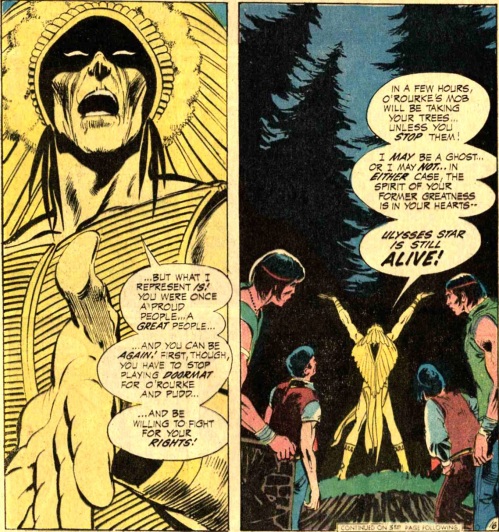
Do you reckon he gets tired, lugging that soap-box around?
Anyway, Black Canary and Green Arrow help the Indians defend their land, and things devolve into a sprawling brawl until the fight is stopped rather definitively by Green Lantern. Notably, his mere arrival is enough to completely end hostilities. He just places a big green wall between the sides and that is that. This is perhaps the most glaring example of his complete mismatch with this setting found in this issue. After all, O’Neil had to send him offstage in order to create any actual dramatic tension in this confrontation. If the Emerald Crusader had been there, the fight would have been over before it started. Essentially, with his setup for this book, O’Neil has painted himself into the same type of corner which the Silver Age faced with Superman, where his power is so vast you have to find ways to handicap him to prevent his resolving the conflict of the plot in the first two pages. The difference is, such a situation is unnecessary with the Lantern, only existing because of the story O’Neil insists on telling.

Of course, this entire escapade is entirely unnecessary. After all, the Native Americans have freaking superheroes on their side. Green Arrow and Black Canary, who regularly fight threats a bit more serious than some unpleasant loggers armed with sticks, threats like legitimately super-powered beings, could easily have trounced these jerks themselves, for whatever good that was going to do. This would probably have been a better option. After all, we’ve already seen that the loggers are willing to kill the Indians in cold blood, and they have access to guns. I’m not really clear on what Arrow’s plan was supposed to accomplish, other than putting some spirit back into the tribe, which wouldn’t matter too much if they were all dead. The matter is made even worse by the fact that this is the second time Ollie has convinced a group of untrained and unqualified civilians to fight a superior force. At least this time he joined them from the beginning, rather than wait until dozens of them were gunned down so that his entrance could be more dramatic. That precious moral superiority of his is on awfully shaky ground.
The immediate danger having been neutralized, Hal announces that he’s brought a U.S. congressman there from Washington to personally investigate this matter, which is actually a pretty good solution, considering the situation and the lack of documentation. So, naturally Ollie congratulates his friend on his quick thinking and they put their efforts into helping the tribe and organizing peaceful protests…err…no, no, that isn’t what happens. That’s entirely too sensible and mature. Instead, the two “friends” decide to have a fist fight in the middle of the stream…for reasons. Green Arrow, still dressed as a yellow ghost, rages against his partner’s solution, and their immediate response is to pummel each other. It’s completely pointless, so much so that even the characters themselves seem to admit that this brouhaha is unnecessary.

O’Neil gets pretty darn purple in his prose as he narrates the fight, which, of course, is beautifully illustrated by Adams, but the highlight of this pointless punch-fest is how it ends. That’s right, this issue gives us, not one, but two, count ’em, two, new entries for the Head-Blow Headcount! Logs being floated down river clock both of our “heroes” in the back of the head, and in classic comic book fashion, they go down like a pair of proverbial sacks of potatoes.

After they’re fished from the river, they go back to the village, where the tribes-folk themselves are split about the plan. Some of them have no faith in the government (I wonder why?), and some of them are determined to make a go of it. In the end, this is really the only option; Green Arrow’s way would have, at best, resulted in all of the tribesmen getting arrested, or perhaps even killed. Apparently he never heard of peaceful protest or civil disobedience. Fortunately, the investigation of the fire at the tenement building revealed (despite Lantern’s ignoring its too-convenient occurrence) that the two trouble-making timbermen were involved in that arson attempt, so they get carted off to jail. The issue ends with our heroes once more gathered around a campfire, admitting that their foolish fight accomplished precisely zilch, and the story closes with a quote from The Armies of the Night, a counter-cultural “nonfiction novel” by Norman Mailer published just two years earlier.

You can definitely see some of the influences at work on O’Neil in his choice of this book. To call it merely anti-war would be an oversimplification, but it dealt with the current cultural issues in the States, centered around opposition to the war in Vietnam. That’s an interesting choice, and I wonder how much of O’Neil’s audience would have read the book, as well as how many would have picked it up after seeing the editor’s note. The evidence of counter-cultural influence in O’Neil’s choice of end-tag is noteworthy given the goals of this project, as we can see quite clearly a line of influence, and a relatively recent one, having an impact on the comic world. It will be interesting to see how that impact spreads in the DCU.
This issue has me a bit torn. On the one hand, the mischaracterization isn’t quite as bad as some of the previous examples we’ve seen, and the story itself is readable enough. On the other, the problems are all those we’ve seen before, and their continued presence makes them more grating and more frustrating with each new book. I’m glad that Hal comes off a bit better here, eventually, but Ollie is still an irrational, self-righteous jerk who, despite his endless lecturing, is something of a hypocrite. The completely pointless fistfight, as well as the uselessness of Arrow’s grand gesture take away from the impact of the story.
What gives me pause, though, is that the central issue, the abuse and neglect of America’s native peoples, is an extremely important one, and, unfortunately, timely today, just as it was in 1970. Ironically, one of the most glaring problems with this issue is that, despite its achingly desperate attempt to be socially conscious, all of the characters in this book, including the Native Americans and supposedly enlightened heroes, talk like actors in a 50s Western. There’s ‘redskins’ this and ‘pale-faces’ that everywhere you look. It’s really rather silly and smacks of the same kind of condescending cliches as Tonto‘s famously broken English. Nonetheless, the plight of the local tribe manages to be moving, perhaps in spite of O’Neil’s treatment.
It is, of course, granted more pathos by the current events of our day, like the protests at Standing Rock. It’s a shame that, after all of these years, we still can’t seem to do right by the native peoples in this country. I won’t get into the entire issue here, as this is hardly the venue for such matters, but I will say that, right or wrong, good, bad, or ugly, when it is the Federal Government versus native peoples, I sort of feel like we should probably give the native peoples the benefit of the doubt at this point. It only seems fair, given our history. Anyway, that made this issue a bit more interesting to me than it might have been otherwise, but in the end, it’s still a story with very flawed writing and characterization that features a situation not really suited for its characters. I’ll give it 2.5 Minutemen. It has enough strong points to keep it above a truly bad rating.

Justice League of America #83

“Where Valor Fails… Will Magic Triumph?”
Writer: Dennis O’Neil
Penciler: Dick Dillin
Inker: Joe Giella
This was yet another great issue of Justice League, which rather wiped the bad taste out of my mouth. O’Neil’s run on the book continues to be consistently good, with fairly compelling stories, solid characterization, and interesting situations. Yet, this particular issue shares a fault with most of his other outings, a somewhat weak and underdeveloped villain. We are picking up with the second part of last issue’s plot, which saw Earth-1 and Earth-1 poised to be destroyed by Supreme Leader Snoke…er…I mean Creator², in his bid to design a new planet with the energy of their annihilation. It’s a wonderfully off-beat idea, and a threat worthy of uniting the JLA and the JSA. Interestingly, this story predates the similar setup in Hitchhiker’s Guide to the Galaxy by almost a decade. I wonder if there’s any influence there.
Unfortunately, Creator² himself, and especially his minions, are just a tad boring. They’re just blue-skinned aliens in robes. There’s nothing distinctive or captivating about them. Still, this run continues to be of high quality overall, and I have a feeling that I will eventually number it among some of my favorite Justice League runs of all time. These stories are still products of their time, however. Even as O’Neil is innovating and shaking things up with the World’s Greatest Super-Heroes, the book can still feel a bit hokey at times. For the most part, though, we’re seeing the League in arguably the best form of the book’s history to this point. Admittedly, that’s not really saying that much, given the goofy, Silver Age-y fare that tended to make up the League’s Adventures.

We begin preciously where we ended, with Canary’s erroneous, but logical, conclusion that she is the cause for the growing convergence of the two Earths. Throughout the book, her hopeless heroism, determined as she is to sacrifice herself for the greater good, is one of the strongest features of the tale. It really works well. She is not some robotic, heartless automaton, blithely giving up her life without a tear or a twinge like we might expect from a Silver Age story. She is fully aware of what this gesture will cost her, and her quiet determination in the face of that knowledge is really rather moving.
Meanwhile, our bathrobe wearing villain is almost ready for the grand finale that will serve to launch his new planet with a bang, but he’s concerned about the JSA, seeing as they’ve already proven tough to handle. He dispatches a set of his weird net devices to disable the team as a preemptive attack. The Society itself is gathered to study their fallen members when the nets arrive, and once again the weapons prove formidable, capturing four members in several pages of nicely dynamic action. As before, each net is capable of neutralizing the powers of its victim, so Staman finds his energy bolts reflected against him, Wonder Woman finds her bracelets bound, and Hourman finds himself accelerated through his hour of power in mere seconds. It’s a good sequence. The only problem is that the nets are fairly lackluster antagonists, being just devices, and not terribly visually interesting ones at that.

Back in Earth-1, we listen in to a desperate conversation, as Canary insists that she must die, and Ollie, his usual cool and rational self, responds about as you’d imagine. He won’t hear of anything happening to Dinah, but Green Lantern has a great third way, exercising that heroic creativity that is so much a part of the concept of American superheroes. He posits that they don’t have to kill the Canary; they just have to move her to another dimension far enough away that the effect will cease. He heads out to search for such a place, to Arrow’s enthusiastic support.

Unfortunately, just as the Emerald Crusader discovers Red Tornado and the dimensional rift, his jade counterpart on Earth-2 is captured, freezing him in place in the depths of space. At almost the same moment, we catch a quick glimpse of Hawkman, out on crowd control, when another strange cross-over occurs and the inhabitants of the two worlds briefly see one another face to face. He saves an old woman, nearly run over in the resulting chaos, but before he can do more, his counterpart is captured as well and he is rendered helpless.

Aboard the Satellite, the remaining heroes fear that Lantern’s absence must mean his failure, and Canary delivers a surprisingly haunting and touching meditation on her death, suggesting that she’ll board the transporter and simply scatter her atoms across space, becoming one with the stars. It’s an impressive scene, made even better by Ollie’s frantic (and rather selfish when you think about it) attempts to talk her out of it. The rational, scientific mind of Ray Palmer takes a more pragmatic view, and he suggests that they wait until the last minute before they make any choices. The scene is really effective, and it’s as fine a piece of character work as you’re likely to see, even today. If O’Neil can do this, one wonders why his characterization is so clumsy and heavy-handed in Green Lantern/Green Arrow.

Dillin really captures Canary’s sorrowful determination.

Meanwhile, on Earth-2, all of the Society members have fallen except for Dr. Fate and Johnny Thunder and his Thunderbolt. Their magic seems to be more effective than the powers of their friends, but they are still fighting a losing battle until the mystic master teleports them to a graveyard, in search of more magical might. Once there, he summons none other than the Spectre! I’m pretty sure we haven’t seen this ghostly gent in this book since issue #47, and we’re quickly given to understand that his status quo has changed quite a bit. Rather than discover him with his human host, Jim Corrigan, Fate finds him in a grave, and the spirit speaks of his sins and his imprisonment in the tomb. It’s an interesting tease, and I’m quite curious what the situation is because I have no memory of any of this. The editor assures us that this story will be told, so I am looking forward to that.

Fortunately, the spectral hero has a plan. His mystic senses have detected the machinations of Creator² and his cronies, and he sends his allies after the villain himself while he uses his very ecotplasmic being to serve as a bulwark between the colliding worlds. The image of this effort is a pretty striking one, emphasizing both the character’s power and the skope of the problem. His desperate ploy buys Dr. Fate and the Thunderbolt the time they need for their assault.

There’s a nice sequence where the aliens detect their approach to their ship and open fire, only for Fate to teleport inside, causing Creator² to assume they’d been vaporized. the effort exhausts the master of the mystic arts, leaving the Thunderbolt to take out the blue-faced minions, but he can’t handle Creator². With one last, titanic exertion, Dr. Fate rips the ship itself apart in a pretty cool panel. The process is halted, and though the release of energy causes some minor tremors, the worlds go back to their rightful places and the day is saved. Yet, the victory comes at a cost. The Spectre is literally torn apart by the dimensional shift. That image, which is half tragic, half comic, isn’t nearly so successful.

Of course, what is completely glossed over in the story is that Dr. Fate just totally killed dozens of beings. He even admits that the aliens probably couldn’t live through that blast. I realize they were preparing to commit dual planetary genocide, and while that’s about the worst crime imaginable, it’s still a bit crazy that Fate casually took several lives without so much as batting an eye. That is definitely a big departure from the Silver Age, but not in a good way. It wouldn’t have bothered me if O’Neil had dealt with that act, even a little bit, but no, it’s completely glossed over as we race to the conclusion of the issue. It’s downplayed so much that I hardly noticed it on my first look, and death shouldn’t’ be treated that lightly in a superhero book, especially when a hero is the cause. I would be more troubled if it were a traditional superhero who had done it, but a mystical character like Fate is always something of a liminal figure. It makes sense that his work and his experience would lead to a somewhat different code than the heroes grounded in more mundane realities.

On a more positive note, on Earth-1 (or more accurately, above it), the Atom detects the dimensional shift, and the heroes celebrate their narrow escape. It’s a good ending, and Ollie’s joy at Canary’s reprieve is really quite charming. He’s already entirely head-over-heels for her, and it definitely comes through. Finally, the Lantern returns and fills them in on the score, leaving them to wonder if they’ll ever see the Spectre again.

This is a good all-around issue. I thoroughly enjoyed it, even if it was, once again, much more of a JSA story than a JLA one. I’m pretty content either way, especially since the Society don’t have a book of their own yet. (I’m looking forward to that one when it arrives, by the way.) This issue managed to pack a lot of action in, as well as some really excellent character moments. Dillin’s art was back up to snuff this month as well, so the book looked quite good. That odd stiffness of last issue is gone, replaced with some truly attractive pages and an overall improvement in quality. I enjoyed the handling of the magical heroes and their triumph. It makes perfect sense that this super-scientific culture would be great at handling all types of threats, except those which defy science, like magic. It’s also pleasant to see Dr. Fate take center stage, as I haven’t gotten to read that many stories that focus on him.
Once again, O’Neil manages to spread the spotlight out pretty well, with nearly everyone getting at least one interesting moment, either in action or in dramatic scenes. The balance between the two types of focus is actually very well handled. The pacing is also quite good, as is the economy of storytelling. He told a complete tale in two issues that had time to breathe and still provided plenty of excitement with appropriately world-shattering stakes. O’Neil continues to turn out good, solid adventure stories in this book, and I’m enjoying the ride. They haven’t been stellar, but they have been consistently good, and that’s rare enough in an ongoing series to deserve praise. Unfortunately, apparently this is the last issue of his tenure on the title. I’ll miss his unique and creative concepts, though I hope we’ll get some more fully realized villains in coming issues. If I recall correctly, there are some really excellent stories awaiting us.
It’s interesting to me that two of the books I look forward to most and the book I most dread are all penned by the same man. It’s striking how very different these comics are from one another. It seems that, perhaps, when forced into more traditional adventure fare, O’Neil really shines. He wouldn’t be the first author who, when let completely off the leash, produced lower quality work because he was too concerned with his own agenda. I’m reminded of the difference between Garth Ennis’s Dan Dare and…well, pretty much everything else he’s ever done. Sometimes limitations can bring out the best in us. This is actually a weakness in the concept of complete artistic freedom, an idea we tend to ascribe almost religious weight to in our culture. I rather think that what’s necessary is a balance of structure and freedom, and that balance is difficult to achieve.
Ideally, the limitations for an artistic work should be internal, the moral and spiritual compass of the creator, but people being what they are, I’m far from convinced that channeling creativity into positive courses is always a bad thing, if done well. That’s something that the tropes of the heroic ideal of the American superhero actually provides rather well. Anyway, back to this particular story, I’ll give it 4.5 Minutemen out of 5. The weak villain and the completely unacknowledged killing by Dr. Fate cut it down from a perfect score. I would have enjoyed seeing Bruce Timm and company take a crack at this story. I think they could have really made something of it.
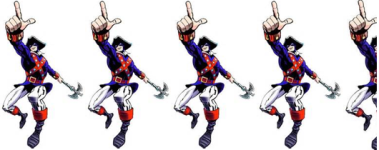
The Head-Blow Headcount:











Another entry for the wall of shame, and this time, it’s a two-fer! How exciting! This month, both Green Arrow and Green Lantern join the ranks of the head-blow heroes. Their moment of infamy is made all the more ludicrous by the fact that it was caused entirely by their own stupidity, resulting during their completely pointless fistfight. It’s a particularly delightful addition to this august company.
Well, that’s it for this week. We’ve had the best and the worst in this post, and we’re almost through September. I’m looking forward to the next batch of commentaries, which will include the final chapter of Manhunter! Please join me next time as we check out another set of stories and travel further Into the Bronze Age!

 “Peril of the Paired Planets”
“Peril of the Paired Planets”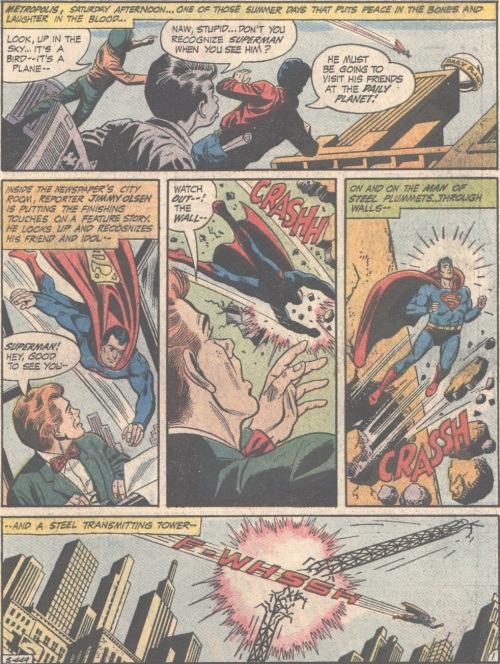

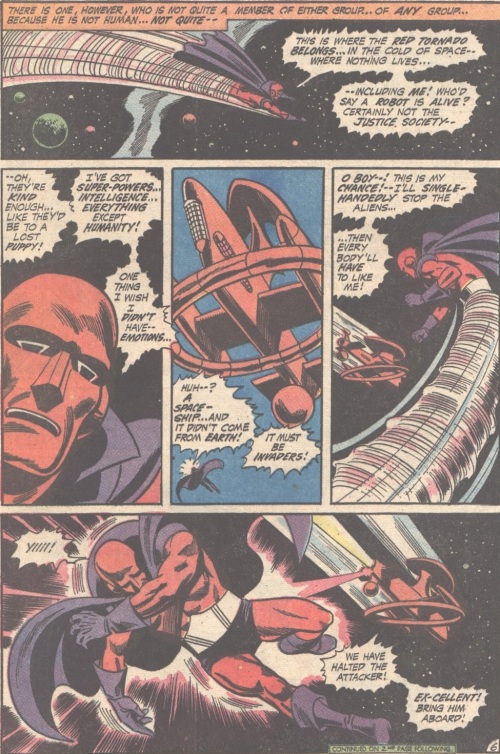
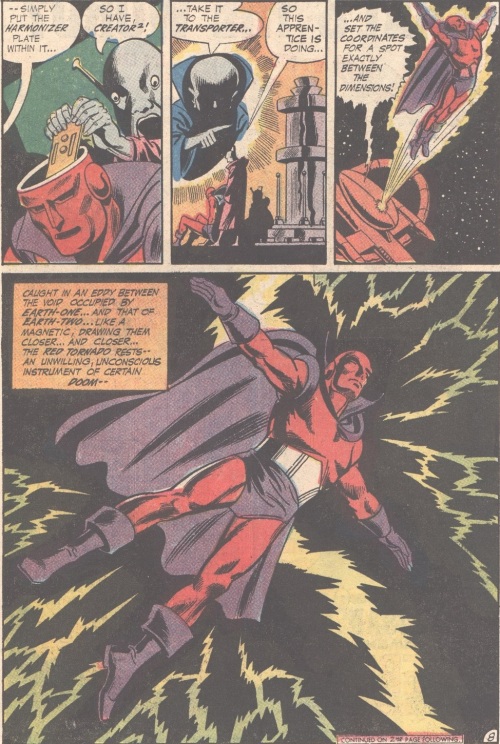
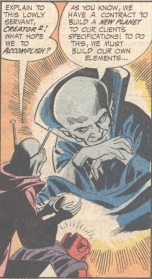 Reddy, of course, fails miserably in his efforts, because for some reason JLA writers decided to make him the team’s whipping boy. Did Super Schlub grow up to be Red Tornado, or what? The afflicted android is captured, and belonging to both Earths, he is able to be used as the focal point for the evil machinations of the planet-wreckers. Power flows through the captive hero, and the two worlds begin to close in on one another, the barriers between them weakening. Meanwhile, the aliens launch a preemptive strike on the JSA to prevent their interference.
Reddy, of course, fails miserably in his efforts, because for some reason JLA writers decided to make him the team’s whipping boy. Did Super Schlub grow up to be Red Tornado, or what? The afflicted android is captured, and belonging to both Earths, he is able to be used as the focal point for the evil machinations of the planet-wreckers. Power flows through the captive hero, and the two worlds begin to close in on one another, the barriers between them weakening. Meanwhile, the aliens launch a preemptive strike on the JSA to prevent their interference.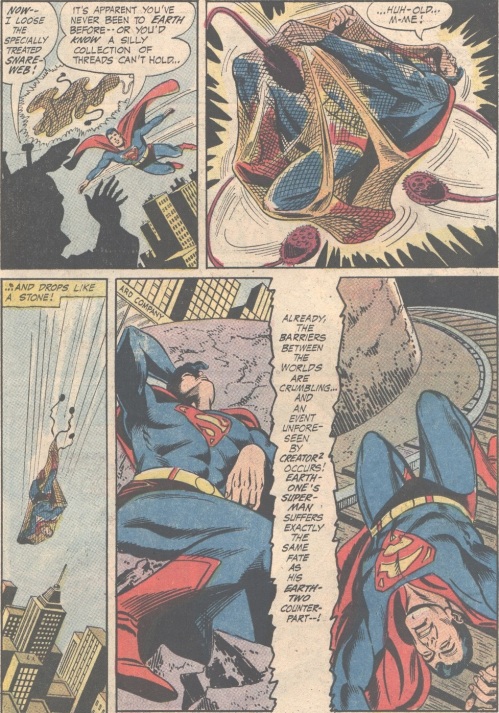

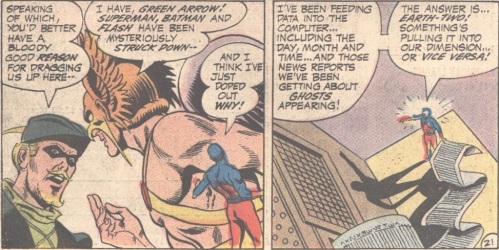
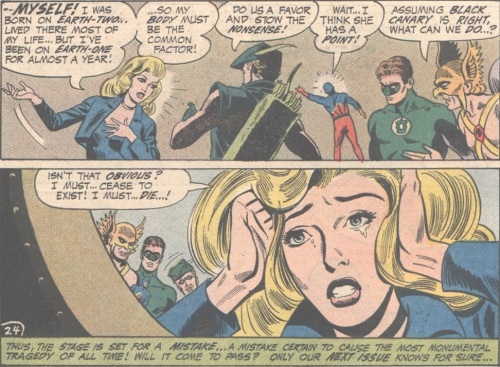

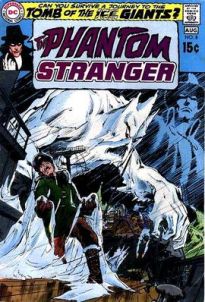 “Journey to the Tomb of the Ice Giants!”
“Journey to the Tomb of the Ice Giants!”
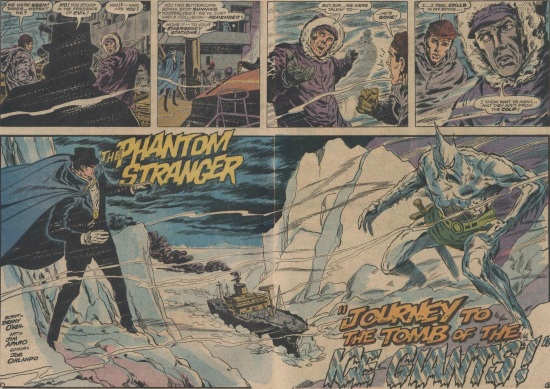
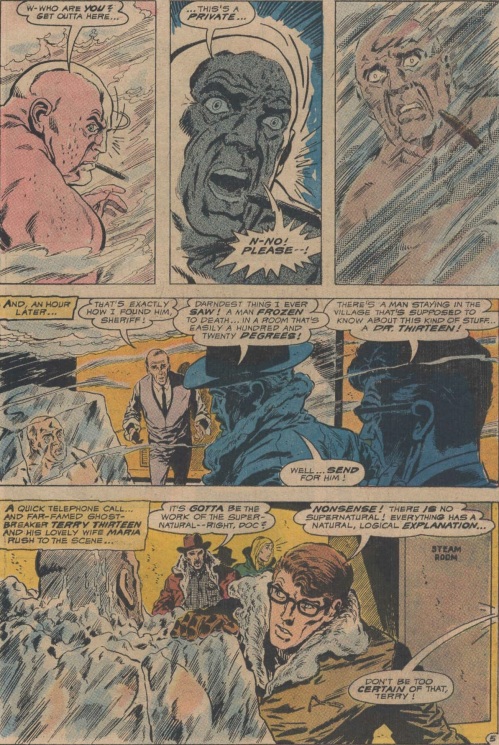
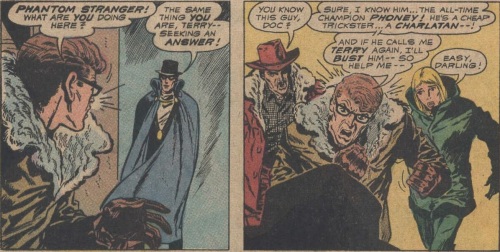
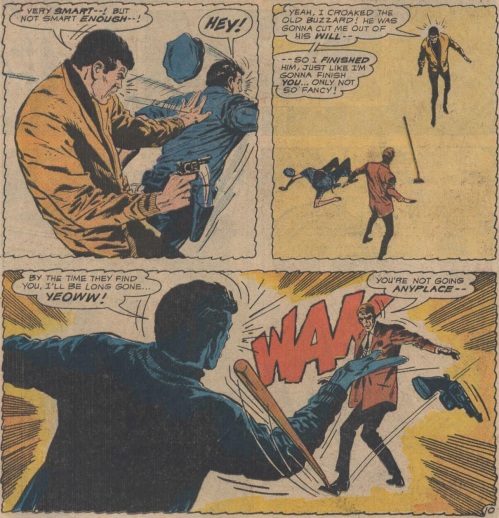

 That’s actually one of the best interpolated episodes we’ve seen so far, with a good mystery, a solid action beat, and Dr. Thirteen actually portrayed to good effect. He’s much more likable here than we’ve seen previously. Back in the main tale, the local chemist (given a ton of personality in his portrayal by Aparo, despite the fact he appears in a grand total of one panel), discovers that the ice entombing Muttson could only have come from the arctic. Thirteen and his wife, sensing a link, prepare a helicopter to fly out and investigate the icebreaker. Before they depart, the Stranger appears with a dire warning, and the Doc actually take a swing at him!
That’s actually one of the best interpolated episodes we’ve seen so far, with a good mystery, a solid action beat, and Dr. Thirteen actually portrayed to good effect. He’s much more likable here than we’ve seen previously. Back in the main tale, the local chemist (given a ton of personality in his portrayal by Aparo, despite the fact he appears in a grand total of one panel), discovers that the ice entombing Muttson could only have come from the arctic. Thirteen and his wife, sensing a link, prepare a helicopter to fly out and investigate the icebreaker. Before they depart, the Stranger appears with a dire warning, and the Doc actually take a swing at him!

